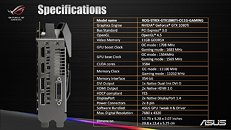- Joined
- Oct 9, 2007
- Messages
- 47,244 (7.55/day)
- Location
- Hyderabad, India
| System Name | RBMK-1000 |
|---|---|
| Processor | AMD Ryzen 7 5700G |
| Motherboard | ASUS ROG Strix B450-E Gaming |
| Cooling | DeepCool Gammax L240 V2 |
| Memory | 2x 8GB G.Skill Sniper X |
| Video Card(s) | Palit GeForce RTX 2080 SUPER GameRock |
| Storage | Western Digital Black NVMe 512GB |
| Display(s) | BenQ 1440p 60 Hz 27-inch |
| Case | Corsair Carbide 100R |
| Audio Device(s) | ASUS SupremeFX S1220A |
| Power Supply | Cooler Master MWE Gold 650W |
| Mouse | ASUS ROG Strix Impact |
| Keyboard | Gamdias Hermes E2 |
| Software | Windows 11 Pro |
Ahead of its launch, specifications of the GeForce GTX 1080 Ti STRIX graphics card by ASUS, appeared on the web thanks to a leaked press-deck. The one spec on most people's minds is the factory-overclock. Out of the box, in the so-called "gaming mode," the card is clocked at 1569 MHz core, 1683 MHz GPU Boost, and an untouched 11 GHz (GDDR5X-effective) memory. The "OC Mode," a clock-speed preset that you activate with the included GPUTweak II software, runs the card at 1594 MHz core, 1708 MHz GPU Boost, and 11.1 GHz memory.
It turns out that the DirectCU III cooler deployed on the GTX 1080 Ti STRIX is indeed beefier than the one found on the GTX 1080 and GTX 1070 STRIX cards; with ASUS claiming up to 30% lower temperatures, thanks to a 40% increase in surface area of the heatsink. ASUS took advantage of the heavier heatsink to lower fan-noise, which it claims to be significantly lower than the reference-design card. The company is also using a newer thermal interface material (TIM) called "MaxContact," which due to its particle density, can get up to 10 times flatter than conventional TIMs, for lower thermal resistance posed by the TIM, and higher conductivity. Display outputs of this card include two each of HDMI 2.0b and DisplayPort 1.4 ports.




View at TechPowerUp Main Site
It turns out that the DirectCU III cooler deployed on the GTX 1080 Ti STRIX is indeed beefier than the one found on the GTX 1080 and GTX 1070 STRIX cards; with ASUS claiming up to 30% lower temperatures, thanks to a 40% increase in surface area of the heatsink. ASUS took advantage of the heavier heatsink to lower fan-noise, which it claims to be significantly lower than the reference-design card. The company is also using a newer thermal interface material (TIM) called "MaxContact," which due to its particle density, can get up to 10 times flatter than conventional TIMs, for lower thermal resistance posed by the TIM, and higher conductivity. Display outputs of this card include two each of HDMI 2.0b and DisplayPort 1.4 ports.




View at TechPowerUp Main Site






